A true partnership is a rare find, and when a pharma client and an ad agency develop one, magical things happen. Much like any relationship, these partnerships take chemistry, communication, transparency, trust, and commitment. Also, setting expectations clearly and up front helps smooth the partnership road.
PharmaVOICE interviewed five client-agency “couples," each with their own challenges and special sauce as to how they developed a winning match. Their stories are highlighted below, complete with helpful tips and hints to make your next client-agency connection a success.
The Agency as the Supporting Cast
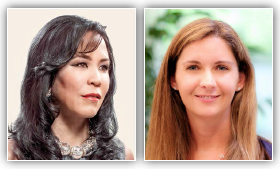 The Couple
The Couple
Didi Discar Principal, Carling Communications
Ashley Kline, Director of Product Marketing, Retina and U.S. Strategic Marketing & Sales, Santen
The Challenge
Ashley Kline, director of product marketing, retina and U.S. strategic marketing and sales, Santen, faces the dual task of launching a new treatment, intravitreal (IVT) sirolimus, that just earned its PDUFA date of Dec. 24, 2017, as well as building a company brand for the U.S. market. Santen, a specialized ophthalmology company with headquarters in Osaka, Japan, has relocated its clinical development base to the United States as it strives to become a global company.
Ms. Kline not only needed to become familiar with uveitis, the leading cause of preventable blindness in working-age adults, but also learn about the company and how to navigate it cross-functionally as she constructed a strategy for IVT. Ms. Kline partnered with Didi Discar, principal, Carling Communications, and they soon became “two sides of the same coin," two partners equally committed to doing what is right for the brand.
The Solution
Without a team of her own, Ms. Kline internalized the agency’s team in a way she hadn’t before. “I’ve had to rely on the Carling team to fill in a lot of gaps for me," she says. “I had so much to do and so much to learn that I needed to lean on Didi and her team pretty hard those first six months. When I saw what can be delivered when we collaborate so closely I realized that I had been approaching agency relationships wrong before."
Ms. Kline learned that agency client relationships can be true partnerships and provide much more than a traditional vendor relationship.
“If you think of your agency as a vendor, you’re not setting yourself up for success and for maximizing what they’re going to do for you," Ms. Kline says.
The partnership was cemented when the two women flew to Japan to present the marketing strategy to the company’s C-suite.
“The way that Didi and I had each other’s backs in that meeting and the alignment that we were able to show the organization did so much for building our relationship and also for bolstering our shared credibility within the company," Ms. Kline recalls. “We left that meeting knowing that we could trust each other and that put us on strong footing for the future."
Just like all relationships, Ms. Discar says that Ms. Kline gets what she gives. “She truly consistently invests into the relationship with the agency," she says. “It helps us to navigate so much more efficiently when a client such as Ashley gives us so much visibility; we can know what she needs before she actually needs it."
The Result
Together, the two women are preparing for launch and gearing up for the Christmas Eve PDUFA date — one of their “high-five" moments among much cheering in both offices.
“The readiness processes that Didi and I have pioneered together, as we build the cross-functional launch, I believe sets the stage for what good looks like," Ms. Kline says. “And that’s a legacy both of us will own."
The Long-lasting Relationship
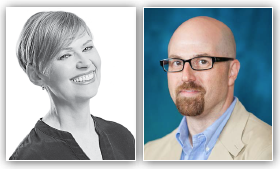 The Couple
The Couple
Robin Shapiro
Global President, TBWA/WorldHealth
Jason Levine
Senior Director, Gilead
The Challenge
Let’s face it, long-term relationships can get stale unless both parties are working to keep the flame alive, and that happens in the client/agency relationship as well. Jason Levine, senior director at Gilead, has experienced this with other agencies in the past; people get complacent, take things for granted, and feel entitled.
“This is a dangerous dynamic for a client–agency relationship," he says. “One of the wonderful things about working with the TBWA team is that they strive every day to maintain the business, and as a client, I love that sort of hunger. They’ve brought this hunger to us on a regular basis, which has been very helpful and has led us to continue what has been a very fruitful relationship for both of us."
“After three consecutive launches of a really large magnitude, people do get tired," says Robin Shapiro, global president, TBWA/WorldHealth. “They need breaks, and they need diversity. Sometimes you have to say it’s time for this person to work on another piece of business for his or her own good and for the good of the business. But again, nothing inspires more than a client that appreciates great work and appreciates the team, and this we have in spades."
Mr. Levine has experience on the agency side, which gives him a unique perspective.
“Having spent a good portion of my career on the agency side, I know the best way to get the best work is to create the strongest partnership that you can," he says. “Honestly, you have to be very careful about the words you use. The words vendor or supplier never make it into the lexicon here because that is not a helpful way of looking at things. The way to have the best agency relationship is for you to be the best client that you can be; be open and honest, give clear and immediate feedback, and set expectations. You demand the best of the agency, but you need to also demand the best of your internal client team, so you know that you’re going to get the best from your partner."
“Success is about staying on top of the relationship and treating each other with respect, honesty, and courage," Ms. Shapiro says.
The Solution
To keep both teams in sync and consistent, TBWA/WorldHealth uses a talent selection strategy that allows agency leaders to choose team members who will be the best fit according to their area of expertise, their personality, and their working styles. In addition, the agency has deployed a unique approach, called Client Success Plans, to push team performance and keep small problems from becoming big problems.
“We’ve set very ambitious goals for client retention and as a result, we’ve done extra work to understand the warning signs that indicate extra attention is needed," Ms. Shapiro says. “A small breakdown can lead to a big breakthrough. Our proprietary process brings a level of rigor to bear, such that we can make this a time-based plan with clear metrics, and also co-create with our clients so we have shared accountability for advancing the relationship. The plan we put in place resolves issues quickly and often leads to new ways of working and innovative ideas. Gilead was one of the first clients for whom we employed this approach. We put a new role into place at the agency as a result of this Client Success Plan."
Understanding the culture of the client is an important factor in both aligning team members and strategy. Mr. Levine learned in his partnership with TBWA that knowing the culture of the agency is also just as important for a successful relationship.
“I learned it’s a two-way street," he says. “As a client, it’s very important for us to teach the Gilead culture to our agency partners, but then we must also be open-minded enough to understand what the agency culture is as well. I would say this was a good learning experience for me."
The Result
Ms. Shapiro credits Gilead with investing in great team-building skills, and that right from the start, Gilead motivated and inspired the client-agency teams.
“What Gilead and Jason did very well was to build a strong, motivated, and inspired agency team," Ms. Shapiro says. “They did that through fun activities, as well as communicating their goals clearly, and inspiring us with the importance of what we’re trying to accomplish together, and how many lives the medicines are going to change. There’s nothing better for attracting and keeping talent than a strong client."
The Integration Relationship
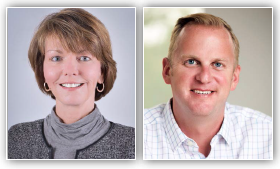 The Couple
The Couple
Annemarie Armstrong
Executive VP, Director of Client Services, Dudnyk
Manny Gaspar
Senior Director, Head of U.S. Hereditary Angioedema Marketing, Genetic Diseases Franchise, Shire
The Challenge
Manny Gaspar, senior director, head of U.S. hereditary angioedema marketing, genetic diseases franchise, Shire, was brand new to the hereditary angioedema disease state, as well as the products associated with it, and he needed an agency partner that completely understood the business and would be thinking ahead about the future. Shire began to restructure around its commercial business, and after review decided there were strategic and tactical synergies between both the acute and the prophylactic product marketplaces, and perhaps only one agency of record was needed.
“It became clear over a matter of time that the partner that was best both strategically, and in terms of the relationship, the knowledge of the marketplace, thinking about our business as a whole, not just the product they had come from, but where we’re going as a franchise, was Dudnyk and the team we ‘inherited,’ we would learn to love," Mr. Gaspar says.
The Solution
“At Dudnyk, our No. 1 priority is to know the client’s business deeply and comprehensively and that goes well beyond the product features and benefits," says AnneMarie Armstrong, executive VP, director of client services, Dudnyk. “We need to know what is happening in the marketplace that may impact the business, whether it is a product in the pipeline, a franchise consideration, or a competitive move. This is our responsibility as an agency partner and a responsibility we take very seriously."
Mr. Gaspar says the agency was consistently thinking about what his team needed to succeed across the enterprise. “I want to emphasize that Dudnyk wasn’t hunting for the business, because that’s a huge don’t for me," he says. “Their approach was genuine and truly credible; they cared about our business and they cared about us as clients in a way that just made sense to us."
Dudnyk does not take earning trust lightly. It requires a concentrated effort to know the client’s business, to consider what is good for the brand, for the brand team, their business, and what ultimately is right for the patient.
Earning that trust comes from an agency doing its homework, Mr. Gaspar says, and there’s no excuse for not knowing something about the brand before going in. If an agency can’t demonstrate in the pitch that it understands the business, it’s a nonstarter for him.
The Result
“In today’s world, every company has a bunch of agency partners, but if they’re not working in concert and there’s not one agency overseeing that things are working together harmoniously, the strategy can get out of whack real quick, and you can end up doing things that aren’t aligned with the vision," Mr. Gaspar says. “Dudnyk really became the quarterback in aligning all of the activities and I’m sure this a challenge that many brands face."
Speaking from the agency side, being able to know when to step up and take the lead regardless of the other agency partners around the table is imperative, Ms. Armstrong says. There are often many agency partners involved in an initiative behind a particular business objective and there needs to be a voice of the customer and the voice of the brand team to drive integration across tactics and channels, because that is the way the healthcare provider or the patient experiences the brand.
“We take the responsibility of trying to knock down the walls between agency partners and just focus on the work," she says. “It’s the work that has to get done and if you can push those walls aside, you can get a lot of work done in a very integrated fashion."
No Transactional Partnering
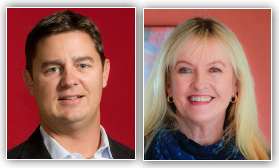 The Couple
The Couple
Peter Rooney
General Manager, Ogilvy CommonHealth NANO
Libby Keating
VP, Marketing, AMAG Pharmaceuticals
The Challenge
When it comes to choosing an agency, Libby Keating, VP, marketing, AMAG Pharmaceuticals, is looking for a partner, not a transactional working relationship. She believes both agency and client should be well versed in the challenges facing the brand and the business to maximize value. She does not require that people “stay in their own lane" when it comes to strategy, tactics, or creative thinking. This allows agencies to have a lot of input, but they must also produce commendable output.
“Sometimes, pharmaceutical companies don’t always know how to work with an agency, and at times marketers will keep their agencies at arm’s length and don’t assimilate them as part of the team," Ms. Keating says. “I expect the opposite from an agency partner. I want a partner that will participate in my team meetings, who understands all the nuances of the brand, and the issues that I’m facing."
Ms. Keating says members of her agency team from Ogilvy are invited to all brand planning meetings and she views them as an extension of her internal team. It is in this way that she gets the most out of the expertise, creativity, and strategic thinking that the agency has to offer.
The Solution
Ms. Keating and Maureen Ruff, VP, management supervisor, Ogilvy CommonHealth, meet once a week on site for the whole day, so Ms. Ruff can get a feel for what is happening in the AMAG world.
“Spending time with Libby and getting to know the cross-functional team, the personalities, and the dynamics helps me feel as though I am a part of her team, and I think it has made our relationship even stronger," Ms. Ruff says.
According to Peter Rooney, general manager, Ogilvy CommonHealth NANO, it is crucial to have honest direct communication to make sure everyone’s expectations are being met. Agencies need to step up and ask the tough questions to make sure they are servicing the client as best they can.
“Especially in relationships that aren’t going well, agency leadership, agency teams, agency account leads are afraid to ask the question: how are we doing?," Mr. Rooney says. “If you can ask that question, then the agency can begin to get to the core of its value to the client and the right type of relationship is built from that point."
The Result
Ms. Keating believes in transparency on both sides, and encourages others to speak up if something is not working.
“If the agency isn’t getting its needs met on core things like collaboration or transparency then we aren’t going to get the best work and vice versa," she says. “This is a best practice, although it doesn’t have to be done formally. With Ogilvy CommonHealth NANO, because we’re such a small team, we check in with each other all the time. I ask: “Our we meeting your needs? Am I giving you the information that you need to be successful or to understand what I need?" This type of check-in is vitally important."
To get the most out of the relationship, it can’t be all about the client, Ms. Keating says, who is the client in this case.
“I’m not always sure that people use agencies in a way that maximizes their greatest value," she says. “Making sure your agency has a seat and a voice at the table is really important versus the client always being the one telling an agency what to do. I think listening to each other helps to establish an environment where the output is great."
Speed Launching
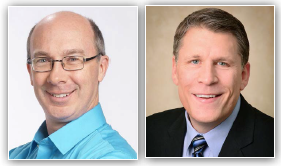 The Couple
The Couple
Greg Niemczyk
VP, Account Director, HCB Health
Mike Walther
VP, Marketing, Aries Pharmaceuticals Inc.
The Challenge
“Here we were, a start-up organization with our first product launch targeted for the first week of May at the world’s largest GI conference," says Mike Walther, VP, marketing, Aries Pharmaceuticals. “We needed to backup from that date to make sure our sales team was trained and ready to go. We had very little time to create what we really wanted to, which was a world-class launch of Eleview, our first medical device product, and GI market introduction for Aries as a company."
Although time was short, Mr. Walther and agency partner Greg Niemczyk, VP, account director, HCB, decided to not cut any steps, but instead to compress the timeframe. That meant that all the steps a client and agency would normally go through to develop a brand, understand its value in the market, its positioning, its core messaging, and then create the campaign and the full armamentarium of customer engagement communication pieces would occur within 16 weeks.
“We didn’t have time for paralysis by analysis," Mr. Niemczyk says. “There was a goal, an objective and an endgame that we all worked toward. So everyone on both the client and the agency side gathered the insights, made informed decisions, and moved forward fast."
The Solution
If an idea was not aligned with the initial goal and objectives, the team would set it aside for review after the launch. There were no distractions.
This effort took a lot of collaboration, efficiency, and the ability to quickly come to a resolution and an agreement of how to move forward.
“Literally, the very first thing we did was spend a good amount of time being very specific around the goals, the objectives, the timelines, and what we were going to accomplish by when and at what level of quality; we were very clear on all of that," Mr. Walther says. “We locked it down and we worked the plan."
As time closed in on them, the two teams remained focused and kept hitting their milestones. However, with only a few weeks left until launch, it was time to stop any more new ideas from entering the timeline, and it was time for excellence mode for final launch readiness. This was just a little bit of a challenge as Mr. Walther still had some ideas he wanted to introduce, but he realized that anything he would have added at that time would have challenged the whole project. The agency wanted to finish up, do high quality work, and deliver on time, and he agreed.
The Result
The key to hitting the deadlines and accomplishing so much in so little time was a product of the two partners coming together to build a common language for the broad Eleview team — a new Aries team that included Mr. Walther and all of his new associates and Mr. Niemczyk and his HCB associates in Chicago and Austin.
“Setting up the team and establishing a common language were the keys to success," Mr. Niemczyk says. “We needed to have a collaborative language for this brand and we needed to have this established quickly. We accomplished it through face-to-face meetings, voice-to-voice conversations, followed by email, and when necessary, by text. We made a concerted effort to ensure we bridged the San Diego-Chicago distance gap by meeting face-to-face once every four weeks. In today’s world, not too many clients are willing to do that. It was a great opportunity to be able to sit in the Aries’ offices for five, six, seven days at a time to solve and to create. This collaboration accentuated and accelerated the end result."
“I think the last important factor that Greg and I always talk about is recognition and then resolution," Mr. Walther says. “We recognized and relied on the talents and expertise of each of the teams. We celebrated successes and in the end, if there was ever a conflict, we were able to quickly get to a resolution and an agreement of how to move forward. I think that’s our recipe: communication, respect, trust, and recognition."
The company’s first medical device, Eleview, was launched May 6, 2017. The device, which has been FDA 510(k) cleared in the United States and CE marked in the EU, is a submucosal injectable composition for extracting polyps and adenomas within the GI tract. (PV)
~~~~~~~~~~~~~~~~~~~~~~~~~
Do’s & Don’ts for Client-Agency Partnerships
We asked several industry experts to voice their opinion on what they consider as their No. 1 “do and don’t" in terms of developing a successful partnership between agencies and clients.
Kim Johnson
President, Palio, part of inVentiv Health
Communications
I believe in the art of partnership. I may be old school that way. But, I believe in being in the foxhole together. And we all know there are more foxholes than ever.
Do: Trust. Trust each other and assume positive intentions. In any agency/client partnership diversity of experience and ideas come together. Trust that this can lead to business building results — for both sides.
DoN’T: Remove your agency prematurely. Never let the annual agency review be the time to communicate expectations and feedback. Feedback is a gift and we should generously provide it to each other regularly. Expect there will be problems. Focus on the solutions. There is too much agency churn in our industry and better goal alignment and open-minded feedback can lead to loyal partnerships and even better work.
Gia Mauriello
Executive VP,
Commercial Excellence, CMI/Compas
The rules around client engagement are simple in theory and tough — but worth it — in practice. Be honest and transparent while building your relationship. Always act swiftly and communicate early and often. Treat the client as a partner and expect the same. We treat our clients’ business as if it were our own business, and show them that we are thinking about their business 24/7, just like they are. Don’t assume they see your commitment; communicate to show it. That’s what builds the trust. If you can show that commitment, then you show how much you care about their business. And that’s when they understand that they’re going to get the best from you.
Do: Always be ready to go above and beyond. To paraphrase the Disney Experience motto, “ok is not ok and good is not good enough." Overdeliver every time you give your client anything, no matter whether it’s a full campaign or a single email. We aim for our clients to find us indispensable. “I could not do what I do without them" is what we want every client to be thinking.
DoN’T: Don’t settle for doing for your client what you would want done for you. Instead do for them as they want to be done for them. The Golden Rule is something we are taught to live by from early in childhood. But it is this Platinum Rule that we think builds best relationships with clients.
Bill McEllen
Head, Saratoga Springs, Fingerpaint
The agency/client relationship is discussed often and with much pontification. As an agency professional who grew up as a client, I think the “secret" to a successful relationship isn’t much of a secret. When it comes down to it, great team dynamics start with a shared belief that people fundamentally want to achieve great things for their brands. Whether it’s a client or an agency professional, everyone wants to see a successful outcome that will ultimately benefit patients.
Do: Create an environment where the best people in the agency want to work on a brand. This means they know they will have the opportunity to do impactful work that will be both valued and appreciated.
DoN’T: Assume that the largest budgets automatically get the best teams. The best people are motivated by the opportunity to do great work with people they enjoy, not by how large the budget is.
Dave Paragamian
Managing Director,
Razorfish
We all love new things: moving into a new apartment or home; driving away from the dealer in the new car; the honeymoon that follows the wedding day. New just feels good. But new doesn’t last. The key to ensuring a successful and productive long-term working relationship is clear communication, especially as the relationship ebbs and flows.
Do: Have conversations about the scope of work and expectations up front. I have found spending time at the outset to define these expectations in detail is the best way to avoid spending even more time and energy later trying to fix problems. This conversation is about way more than scope of work.
DoN’T: Avoid uncomfortable conversations. Addressing both the client’s and the agency’s expectations in the beginning of any relationship can prevent a complete breakdown in the relationship. It creates a more constructive work environment overall. There is always room for a client-agency relationship to be fresh, productive, and exciting; however, it takes preparation up front from the most senior parties to align and work through the details to stay committed. In the past decade of running large advertising agencies, I’ve learned that client relationships are like any other relationship; they are not static and need constant work.
Barry Schmader
Chief Creative Officer, Elevate Health
Let’s start with the premise that creative teams should be part of building strong client relationships, which is not always the case in every agency. The single most important lesson I have learned about creative people and client relationships is to understand why a client has entered into a relationship with your agency and with you in particular. As a creative person you provide something unique — you have a different thought process than the client has. Simply put, no one in the client’s organization thinks quite like you do, which brings value to the relationship. It’s not about being buddies or being in lockstep with a client on how you think and act, but keeping a friendly, open relationship based on mutual respect of each other’s disciplines to achieve a mutual goal. Paraphrasing Andrew Carnegie “If two people in business always agree on everything, one of them is unnecessary." I have found that the strongest client-agency bonds, even those between the creative staff and the client, are forged on the principles of bringing equal value to each others’ tables, and on the free exchange of ideas and opinions, all in pursuit of quality work and a quality relationship.
Do: Allow, facilitate, and encourage creative people to establish close relationships with clients. It certainly improves the process with collaborative and open communications, and ultimately makes the work better as well.
DoN’T: Buy into the school of thought that account teams exclusively own relationships, or that it’s best to keep the creative people somewhat detached from the client. The reasons some agencies do this are varied, for example, rotating teams working on the brand, or the creative leadership on the brand is working on many other brands at the same time, or the belief that some detachment is required to think objectively about the brand. These are situations where an agency may think it preferable to keep some distance between creative people and the client. But I find this is not the way to go. For me, the work and the relationship only get stronger with more interaction and collaboration occurs, not less.

















